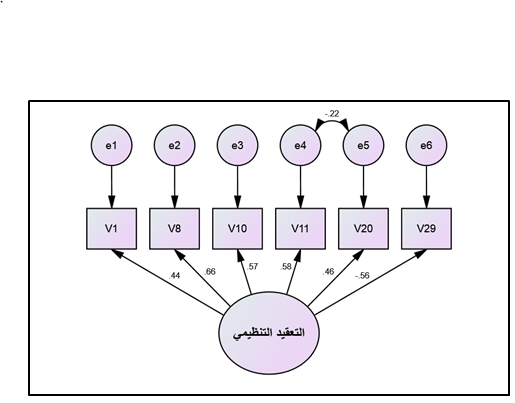The Intermediate Role of Organizational Justice in the Relationship between Organizational Complexity and Performance Effectiveness of Human Resources
Keywords:
Organizational complexity, organizational justice, and performance effectiveness of human resources.Abstract
This research seeks to determine the intermediate effect of organizational justice in its dimensions (distributive justice, procedural justice, interactive justice) in the relationship between the organizational complexity and performance effectiveness of human resources in their dimensions (performance quality, performance effectiveness, communication, decision making). The problem of research is that organizational complexity increases because of its vulnerability to the troubled environment, which has been reflected in its negative impact on organizational justice and the effectiveness of human resources performance. The University of Karbala was chosen as a field of research and was based on the questionnaire which included (271) academic staff. We used empirical analysis and several meta-statistics for correlation and impact analysis. They have achieved several research hypotheses. We reached several important conclusions and recommendations. One of the most important findings was the contribution of organizational justice to reducing the indirect impact of an organizational complexity on the effective performance of human resources. We showed the reasons for these results. We also recommend strengthening information justice as it contributes to reducing organizational complexity.
References
الحسناوي، حسين حريجة؛ عباس، علي عبد الحسن. (2017) العلاقة التأثيرية بين متعة العمل والمقدرات الجوهرية للموارد البشرية عن طريق الدور الوسيط لرأس المال النفسي، المؤتمر الدولي التاسع للمدة من 28-29 /3/2017, المجلد الثاني لكلية الإدارة والاقتصاد، جامعة كربلاء، العراق. 1489-1521.
الرويلي، عماد سفوك جلود. (2014). نظم معلومات الموارد البشرية لتعزيز فاعلية إدارة الموارد البشرية. دراسة تطبيقية فيوزارة الداخلية في مملكة البحرين، مملكة البحرين، جامعة العلوم التطبيقية، كلية العلوم الإدارية.
العميرة، محمد بن عبد العزيز. (2003) علاقة الجودة الشاملة بالأداء الوظيفي في القطاع الصحي. رسالة ماجستير مقدمة الى كلية الدراسات العليا قسم العلوم الإدارية. اكاديمية نايف العربية للعلوم الأمنية. الرياض. 1-117.
بن علي، مهملي. (2016) متخذ القرار الرشيد فيفاعلية تقييم الأداء داخل المؤسسة. مخبر الدراسات الاجتماعية والنفسية والأنثروبولوجي، المركز الجامعي احمد زبانه، غليزان، الجزائر، مجلة الرواق. المجلد 3. العدد 3. 130-150.
بن علي، مهملي. (2016) أهمية اللغة عند متخذ القرار وتأثيرها فيفاعلية الأداء الوظيفي. وحدة تنمية الموارد البشرية جامعة محمد لامين دباغين، سطيف الجزائر، مجلة تنمية الموارد البشرية. المجلد 7. العدد 2. 25-51.
عودة، قصير بن، يوب، مختار. (2017) إدارة الجودة الشاملة وعلاقتها بالأداء الوظيفي. مجلة العلوم الإنسانية والاجتماعية، الجزائر. العدد 31. 368-357.
سيدن، باباه ولد. (2010) دور الموارد البشرية في التأثير فيالأداء. رسالة ماجستير مقدمة الى كلية العلوم الاقتصادية والتسيير والعلوم التجارية. جامعة ابي بكر بلقايد تلمسان. الجزائر. 1-97.
شنب، ايمان محمد أبو. (2013) دور ممارسة مديري مدارس وكالة الغوث بمحافظة غزة لمهارات التواصل وعلاقتها بفاعلية الأداء. رسالة ماجستير مقدمة الى كلية التربية، عمادة الدراسات العليا. الجامعة الإسلامية في غزة. 1-202.
رزيقة، نجعوم، وسميرة، العمري. (2015) دور الاتصال التنظيمي في تفعيل الأداء الوظيفي في المؤسسة الاقتصادية الجزائرية. رسالة ماجستير مقدمة الى كلية العلوم الإنسانية والاجتماعية. جامعة العربي بن مهدي. الجزائر. 1-202.
Almahdi, Mohamed Maatouq, & Alsalami, Ashwaq Jassim. (2014). Evaluation of the performance of human resources management and its impact on improving the performance of the organization. A case study at the center of the Iraqi Ministry of Oil. Journal of Baghdad College of Economic Sciences University, issue. 39, 283-310.
Al-Rawi, K. (2008). Cohesiveness within teamwork: the relationship to performance effectiveness–case study. Education, Business and Society: Contemporary Middle Eastern Issues, 1(2), 92-106.
Anderson, D. M., & Shinew, K. J. (2003). Gender equity in the context of organizational justice: A closer look at a reoccurring issue in the field. Journal of Leisure Research, 35(2), 228-247.
Anderson, P. (1999). Perspective: Complexity theory and organization science. Organization science, 10(3), 216-232.
Anderson, P., Meyer, A., Eisenhardt, K., Carley, K., & Pettigrew, A. (1999). Introduction to the special issue: Applications of complexity theory to organization science. Organization Science, 10(3), 233-236.
Anish, S., & Gupta, A. (2010). Insights from Complexity Theory: Understanding Organizations Better. ISSUES.
Baeder, Justin. (2011). Performance or Effectiveness? A Critical Distinction for Teacher Evaluation. Available at: https://blogs.edweek.org/edweek/on_performance/2011/10/performance_or_effectiveness_a_critical_distinction_for_teacher_evaluation.html , It was obtained: 22/December/2018.
Bernerth, J. B., Armenakis, A. A., Feild, H. S., & Walker, H. J. (2007). Justice, cynicism, and commitment: A study of important organizational change variables. The Journal of Applied Behavioral Science, 43(3), 303-326.
Beugr, C. D. (2002). Understanding organizational justice and its impact on managing employees: An African perspective. International Journal of Human Resource Management, 13(7), 1091-1104.
Bhagat, R. S. (1983). Effects of stressful life events on individual performance effectiveness and work adjustment processes within organizational settings: A research model. Academy of Management Review, 8(4), 660-671.
Bickhard, M. H., & Campbell, D. T. (2003). Variations in variation and selection: The ubiquity of the variation-and-selective-retention ratchet in emergent organizational complexity. Foundations of Science, 8(3), 215-282.
Bickhard, M. H., & Campbell, D. T. (2003). Variations in variation and selection: The ubiquity of the variation-and-selective-retention ratchet in emergent organizational complexity. Foundations of Science, 8(3), 215-282.
Birkinshaw, J., & Heywood, S. (2010). Putting organizational complexity in its place. McKinsey quarterly, 3, 122-127.
Boisot, M., & Child, J. (1999). Organizations as adaptive systems in complex environments: The case of China. Organization Science, 10(3), 237-252.
Borman, W. C. (1979). Individual differences correlates of accuracy in evaluating others' performance effectiveness. Applied Psychological Measurement, 3(1), 103-115.
Bray, S. R., & Brawley, L. R. (2002). Role efficacy, role clarity, and role performance effectiveness. Small Group Research, 33(2), 233-253.
Bray, S. R., & Brawley, L. R. (2002). Role efficacy, role clarity, and role performance effectiveness. Small Group Research, 33(2), 233-253.
Briscoe, G. (2010, October). Complex adaptive digital ecosystems. In Proceedings of the International Conference on Management of Emergent Digital EcoSystems (pp. 39-46). ACM.
Broadbent, D. P., Gredin, N. V., Rye, J. L., Williams, A. M., & Bishop, D. T. (2018). The impact of contextual priors and anxiety on performance effectiveness and processing efficiency in anticipation. Cognition and Emotion, 1-8.
Broadbent, D. P., Gredin, N. V., Rye, J. L., Williams, A. M., & Bishop, D. T. (2018). The impact of contextual priors and anxiety on performance effectiveness and processing efficiency in anticipation. Cognition and Emotion, 1-8.
Brown, S. L., & Eisenhardt, K. M. (1997). The art of continuous change: Linking complexity theory and time-paced evolution in relentlessly shifting organizations. Administrative science quarterly, 1-34.
Byrne, B. M. (2016). Structural equation modeling with AMOS: Basic concepts, applications, and programming. Routledge.
Buluc, B., & Gunes, M. (2014). Relationship between organizational justice and organizational commitment in primary schools. The Anthropologist, 18(1), 145-152.
Butler, A. M., & Chung-Yan, G. A. (2011). The influence of sexual harassment frequency and perceptions of organizational justice on victim responses to sexual harassment. European journal of work and organizational psychology, 20(6), 729-754.
Carr, J. D., & Maxwell, S. R. (2018). Police officers’ perceptions of organizational justice and their trust in the public. Police Practice and Research, 19(4), 365-379.
Chan, S., & Jepsen, D. M. (2011). Workplace relationships, attitudes, and organizational justice: A hospitality shift worker contextual perspective. Journal of Human Resources in Hospitality & Tourism, 10(2), 150-168.
Chang, C. C., & Dubinsky, A. J. (2005). Organizational justice in the sales force: A literature review with propositions. Journal of Business-to-Business Marketing, 12(1), 35-71.
Cheng, S. Y. (2014). The mediating role of organizational justice on the relationship between administrative performance appraisal practices and organizational commitment. The International Journal of Human Resource Management, 25(8), 1131-1148.
Cho, Y. J. (2017). Organizational justice and complaints in the US federal workplace. International Review of Public Administration, 22(2), 172-192.
Chory, R. M., & Kingsley Westerman, C. Y. (2009). Feedback and fairness: The relationship between negative performance feedback and organizational justice. Western journal of communication, 73(2), 157-181.
Costa, A. C., Roe, R. A., & Taillieu, T. (2001). Trust within teams: The relation with performance effectiveness. European journal of work and organizational psychology, 10(3), 225-244.
Cox, K. B. (2003). The effects of intrapersonal, intragroup, and intergroup conflict on team performance effectiveness and work satisfaction. Nursing administration quarterly, 27(2), 153-163.
Daryani, Shahram Mirzaei., & Amini, Amir. (2016). Management and Organizational Complexity. Procedia - Social and Behavioral Sciences 230, 359 – 366.
Davis, D., & Galbraith, R. (2009). Continuing medical education effect on practice performance: effectiveness of continuing medical education: American College of Chest Physicians Evidence-Based Educational Guidelines. Chest, 135(3), 42S-48S.
El Ashker, S. (2012). Technical performance effectiveness subsequent to complex motor skills training in young boxers. European Journal of Sport Science, 12(6), 475-484.
Faucher, J. B. P., Everett, A. M., & Lawson, R. (2008). A complex adaptive organization under the lens of the LIFE model: the case of Wikipedia. In Proceedings of the 11th McGill international entrepreneurship conference, Dunedin.
Fioretti, G., & Visser, B. (2006). A cognitive approach to organizational complexity. In Systemics of emergence: research and development (pp. 495-513). Springer, Boston, MA.
Forteza, F. J., Carretero-Gómez, J. M., & Sese, A. (2017). Effects of organizational complexity and resources on construction site risk. Journal of safety research, 62, 185-198.
Gell-Mann, M. (2002). What is complexity?. In Complexity and industrial clusters (pp. 13-24). Physica-Verlag HD.
Girod, S. J., & Whittington, R. (2015). Change escalation processes and complex adaptive systems: From incremental reconfigurations to discontinuous restructuring. Organization Science, 26(5), 1520-1535.
Goh, G. (2013). The difference between effectiveness and efficiency explained. RAMP The Insight Squared Blog.
Goodboy, A. K., Chory, R. M., & Dunleavy, K. N. (2008). Organizational dissent as a function of organizational justice. Communication Research Reports, 25(4), 255-265.
Greenberg, J. (2002). Advances in organizational justice. Stanford University Press.
Hansen, A. M., Byrne, Z. S., & Kiersch, C. E. (2013). Development and validation of an abridged measure of organizational justice. The Journal of psychology, 147(3), 217-244.
Heaslip, R. J. (2014). Managing Complex Projects and Programs: How to Improve Leadership of Complex Initiatives Using a Third-generation Approach. John Wiley & Sons.
Heaslip, R. J. (2015). Managing organizational complexity: How to optimize the governance of programs and projects to improve decision making. Project Management Institute, Newtown, PA.
Heide, M., von Platen, S., Simonsson, C., & Falkheimer, J. (2018). Expanding the scope of strategic communication: Towards a holistic understanding of organizational complexity. International Journal of Strategic Communication, 12(4), 452-468.
Holland, J. H. (2006). Studying complex adaptive systems. Journal of Systems Science and Complexity, 19(1), 1-8.
Johnston, C. S., Krings, F., Maggiori, C., Meier, L. L., & Fiori, M. (2016). Believing in a personal just world helps maintain well-being at work by coloring organizational justice perceptions. European Journal of Work and Organizational Psychology, 25(6), 945-959.
Jordan, J. S., & Turner, B. A. (2008). The feasibility of single-item measures for organizational justice. Measurement in Physical Education and Exercise Science, 12(4), 237-257.
Kane, J. S. (1996). The conceptualization and representation of total performance effectiveness. Human Resource Management Review, 6(2), 123-145.
Kyle, M. J., & White, D. R. (2017). The impact of law enforcement officer perceptions of organizational justice on their attitudes regarding body-worn cameras. Journal of crime and justice, 40(1), 68-83.
Lawler, E. (2012). Effective human resource management: A global analysis. Stanford University Press.
Lewin, A. Y. (1999). Application of complexity theory to organization science. Organization Science, 10(3), 215-215.
Lind, A. (2007). Handbook of Organizational Justice–Edited by Jerald Greenberg and Jason A. Colquitt. British Journal of Industrial Relations, 45(1), 212-214.
Malott, M. E., & Martinez, W. S. (2006). Addressing organizational complexity: A behavioural systems analysis application to higher education. International Journal of Psychology, 41(6), 559-570.
Markusen, A. (2010). Organizational complexity in the regional cultural economy. Regional Studies, 44(7), 813-828.
Marshall, V., & Wood, R. E. (2000). The dynamics of effective performance appraisal: an integrated model. Asia Pacific Journal of Human Resources, 38(3), 62-90.
Mashi, M. S. (2018). The Mediating role of job satisfaction in the relationship between organizational justice and employee outcomes. International Journal of Public Administration, 41(16), 1351-1360.
Mayer, D. M., Bardes, M., & Piccolo, R. F. (2008). Do servant-leaders help satisfy follower needs? An organizational justice perspective. European Journal of Work and Organizational Psychology, 17(2), 180-197.
McMillan, E. (2008). Complexity, management and the dynamics of change: Challenges for practice. Routledge.
Mihalicz, Dwight. (2013). The HR Perspective on Performance Management and Effectiveness Management. Available at: https://effectivemanagers.com/dwight-mihalicz/the-hr-perspective-on-performance-management-and-effectiveness-management/ . It was obtained: 22/December/2018.
Mitleton-Kelly, E. (2003). Ten principles of complexity and enabling infrastructures. Complex systems and evolutionary perspectives on organisations: The application of complexity theory to organisations, 1, 23-50.
Moliner, C., Cropanzano, R., & Martínez-Tur, V. (Eds.). (2017). Organizational justice: International perspectives and conceptual advances. Taylor & Francis.
Moliner, C., Martinez-Tur, V., Ramos, J., Peiró, J. M., & Cropanzano, R. (2008). Organizational justice and extrarole customer service: The mediating role of well-being at work. European Journal of Work and Organizational Psychology, 17(3), 327-348.
Moorman, R. H. (1991). Relationship between organizational justice and organizational citizenship behaviors: Do fairness perceptions influence employee citizenship?. Journal of applied psychology, 76(6), 845.
Piccolo, R. F., Bardes, M., Mayer, D. M., & Judge, T. A. (2008). Does high quality leader–member exchange accentuate the effects of organizational justice?. European Journal of Work and Organizational Psychology, 17(2), 273-298.
Pollack, J., & Remington, K. (2012). Tools for complex projects. Gower Publishing, Ltd..
Pollock, Sara. (2018). 6 Strategies for Effective Performance Management. Available at: https://hrdailyadvisor.blr.com/2018/01/11/6-strategies-effective-performance-management/ . It was obtained: 22/December/2018.
Reisel, W. D., Chia, S. L., & Maloles Iii, C. M. (2005). Job insecurity spillover to key account management: Negative effects on performance, effectiveness, adaptiveness, and esprit de corps. Journal of Business and Psychology, 19(4), 483-503.
Richard, O. C., & Johnson, N. B. (2001). Strategic human resource management effectiveness and firm performance. International Journal of Human Resource Management, 12(2), 299-310.
Rizzo, J. R., House, R. J., & Lirtzman, S. I. (1970). Role conflict and ambiguity in complex organizations. Administrative science quarterly, 150-163.
Salman, Fadel Hamad, & Mahawei, Rafid Abdel Wahed. (2016). The role of practices by the Managing of human resources on effectiveness of organizational crisis Management Described and analysis research for ministry of Iraqi interior. Journal of Economic and Administrative Sciences, Vol 22 (94), 183-203.
Saunders, M., Lewis, P., & Thornhill, A. (2009). Research methods for business students fifth edition (fifth), Pearson Education Limited.
Schwandt, Alexander. (2009). Measuring organizational complexity and its impact on organizational performance – A comprehensive conceptual model and empirical study. Doktor der Wirtschaftswissenschaften, von der Fakultät VII (Wirtschaft und Management) der Technischen Universität Berlin. Pp.1-189.
Scott, W. R., & Meyer, J. W. (1984). Environmental Linkages and Organizational Complexity: Public and Private Schools.
Seppålå, P., & Salvendy, G. (1985). Impact of depth of menu hierarchy on performance effectiveness in a supervisory task: Computerized flexible manufacturing system. Human Factors, 27(6), 713-722.
Sindhav, B. (2001). The role of organizational justice in managing change within marketing channels. Journal of Marketing Channels, 9(1-2), 65-91.
Stacey, R. D. (1996). Complexity and creativity in organizations. Berrett-Koehler Publishers.
Theuvsen, L. (2004). Doing better while doing good: Motivational aspects of pay-for-performance effectiveness in nonprofit organizations. Voluntas: International Journal of Voluntary and Nonprofit Organizations, 15(2), 117-136.
Tziner, A., & Vardi, Y. (1982). Effects of command style and group cohesiveness on the performance effectiveness of self-selected tank crews. Journal of Applied Psychology, 67(6), 769.
Van der Waal, C. S. (2005). Spatial and organisational complexity in the Dwars River Valley, Western Cape. Anthropology Southern Africa, 28(1-2), 8-21.

Downloads
Published
How to Cite
Issue
Section
License
Copyright (c) 2024 Economics and Administration College - Karbala University

This work is licensed under a Creative Commons Attribution-NonCommercial-NoDerivatives 4.0 International License.
Authors retain the copyright of their papers without restrictions.









